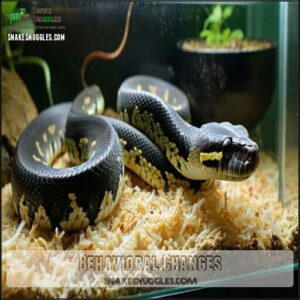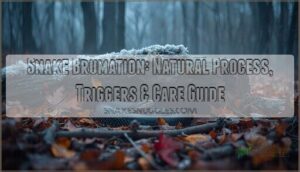This site is supported by our readers. We may earn a commission, at no cost to you, if you purchase through links.

They’ll often press their nose against the glass, track your movements, or prowl their enclosure like they’re on a mission. Some snakes might become more aggressive or strike at movement, basically saying "feed me now!"
You might also catch them hanging around their feeding spot, hoping for dinner to magically appear. Each species has its own hunger cues, so you’ll soon learn your scaly friend’s particular "I’m starving" dance.
Understanding these behaviors helps guarantee your reptilian companion maintains peak health throughout their long lifespan, and recognizing these signs is crucial for their overall well-being and to ensure you provide the best care, which includes maintaining their long lifespan.
Table Of Contents
- Key Takeaways
- Recognizing Hunger Signs
- Feeding Schedule Factors
- Environmental Impact
- Health Issues and Hunger
- Addressing Hunger Concerns
- Frequently Asked Questions (FAQs)
- What do snakes do when they are hungry?
- How do you know when a snake is hungry?
- How often do snakes get hungry?
- How do I know if my snake needs bigger food?
- How do snakes hunt in the wild?
- Do snakes remember their feeding routine?
- Can snakes overeat when very hungry?
- Why do snakes yawn before eating?
- How do snakes digest after feeding?
- Conclusion
Key Takeaways
- You’ll notice increased activity when your snake is hungry, including frequent prowling around the enclosure, more tongue flicking, and active exploration of their environment.
- Your snake’s feeding needs vary based on age, species, and individual metabolism—juveniles typically need feeding twice weekly while adults may eat every 1-2 weeks.
- Temperature and humidity directly affect your snake’s appetite and digestion; incorrect environmental conditions can suppress hunger cues and cause feeding problems.
- Watch for concerning signs like persistent food refusal, weight loss, or lethargy, which may indicate health issues rather than normal hunger and require veterinary attention.
Recognizing Hunger Signs
You’ll notice your snake is hungry when it begins prowling around its enclosure and flicking its tongue more frequently than usual.
These hunger signals are your reptilian friend’s way of saying "it’s dinnertime," much like how your stomach growls when you’re ready for a meal, which is a clear indication that your snake needs to be fed, and recognizing this "hunger signal" is crucial for its care.
Recognizing when your snake prowls and flicks its tongue more often is like understanding their version of a rumbling stomach.
Behavioral Changes
A keen observer will notice distinct behavioral changes when your snake gets hungry.
Your reptilian friend will communicate its need for a meal through clear signals.
- Increased prowling along enclosure edges, especially near doors
- Tongue flicking becomes more frequent and vigorous
- Hiding changes with less time spent in favorite spots
- Alert posture with raised head and focused gaze
- Begging behavior like following your movements
Understanding corn snake body language can further clarify these cues.
Increased Activity
Searching for prey becomes a priority when your snake is hungry.
You’ll notice increased activity through restless prowling and constant enclosure exploration. Your normally docile pet might suddenly transform into a miniature explorer, checking every corner with heightened alertness.
This hunting behavior typically includes more frequent tongue flicks to "taste" the air for food particles.
Some snakes even attempt escapes when their stomach starts rumbling – they’re simply following their natural snake searching behavior.
Aggressive Behavior
Your snake might lash out when hunger kicks in, showing defensive striking and increased biting risk during handling.
Temperament changes are common when they’re famished – even typically docile snakes can display fear aggression.
Watch for these hunger signs: striking at movement near the enclosure, hissing, or mouth gaping.
These handling challenges aren’t personal attacks; they’re simply your snake’s way of communicating "I’m ready for dinner!
Restlessness
A restless reptile is showing you clear hunger signals. When your snake’s exploring every corner of their enclosure instead of lounging in their favorite spot, they’re likely searching for their next meal.
- Watch for frequent hide shifting and unusual movement between different areas
- Notice increased pacing behavior along enclosure walls
- Be alert to escape attempts, which often indicate active hunting mode
When these snake hunger signs appear, mealtime is approaching!
Feeding Schedule Factors
You’ll need to adjust your snake’s feeding schedule based on their age, species, and individual metabolism to keep them healthy and satisfied.
Understanding these factors won’t just prevent hunger strikes but will also help you develop that special mealtime connection that makes your scaly friend perk up when you approach their enclosure, which can lead to a stronger bond and a special mealtime connection.
Age and Species Considerations
While observing behavioral signs of hunger is important, your snake’s feeding needs will vary dramatically based on their life stage and type.
Juvenile snakes typically need more frequent meals (up to twice weekly), while adults might eat just a few times monthly.
Species-specific feeding is essential – what works for a ball python won’t suit a corn snake.
During shedding periods, most snakes naturally fast. Pregnant females often develop varying appetites requiring more food before breeding season, which can be a critical time for their nutritional needs.
Dietary Requirements
Every snake has specific dietary needs that directly impact their feeding cues. Your scaly friend requires whole prey animals matching their body diameter for proper nutrition.
Frozen prey (thawed to room temperature) is safer than live options, which can injure your snake. Many owners conveniently source snake’s frozen rodents online.
Vary their diet between appropriate rodents, birds, or insects based on species requirements. Remember, proper nutrition affects not just hunger signals but overall health and behavior.
Feeding Frequency
While young snakes need feeding every 5-7 days, adults typically eat every 1-2 weeks, depending on their species.
You’ll notice hungry snake behavior increasing as their regular feeding time approaches, and pay attention to snake feeding cues like increased activity and tongue flicking.
Consistent schedules help establish healthy snake appetite changes, and remember, prey size matters—it shouldn’t exceed your snake’s widest body part to avoid overfeeding risks.
Environmental Impact
Your snake’s environment directly affects its appetite, with factors like temperature, humidity, and stress playing vital roles in their feeding behavior.
You’ll notice your hungry snake becoming more active in proper conditions, while poor enclosure setup can mask hunger cues that you’d otherwise easily spot, related to their feeding behavior.
Temperature and Humidity
Beyond feeding schedules, your snake’s environment plays a major role in appetite.
Temperature and humidity aren’t just comfort factors—they’re directly linked to your snake’s digestive system and hunger cues.
- Too cold? Your snake’s metabolism slows, reducing hungry snake behavior
- Too hot? Dehydration occurs, suppressing appetite
- Incorrect humidity levels often cause shedding issues and stress
- Seasonal adjustments may naturally affect feeding patterns
- Regular thermostat calibration guarantees proper gradients for digestion
Maintaining a proper basking surface temperature is essential for their well-being.
Stress and Handling
While managing temperature, don’t overlook how handling affects your snake’s appetite.
Frequent handling can stress your pet, leading to feeding refusal, and your snake may view you as a predator rather than a friend.
Limit interactions before meals and avoid handling for 48 hours after feeding to prevent regurgitation.
A stressed snake won’t eat – look for hiding, defensive postures, or hissing as warning signs that your handling routine needs adjustment.
Enclosure Conditions
Your snake’s enclosure conditions play a pivotal role in their feeding habits and overall health. When their habitat doesn’t meet proper requirements, they may refuse food altogether.
Understanding proper thermal gradients is essential for reptile care.
- Temperature gradients must range from warm to cool zones for proper digestion
Temperature gradients aren’t just comfort features—they’re your snake’s built-in digestive system activator.
- Humidity levels affect shedding ability and feeding response
- Hiding spots provide security, reducing stress-related feeding issues
- Enclosure size should match your snake’s length (at least as long as the snake)
- Water access is essential for hydration and hunting behavior
Health Issues and Hunger
You’ll need to distinguish between normal hunger signals and potential health problems when caring for your snake.
Persistent refusal to eat, unexplained weight loss, and unusual behaviors may indicate underlying health issues that require veterinary attention rather than just a hungry reptile.
Refusal to Eat
Despite regular feeding attempts, your snake’s refusal to eat might signal more than just a picky appetite.
Several factors could be contributing to this snake anorexia, which requires careful attention. One such factor is lethargy and inactivity, which can indicate a serious underlying health issue.
| Cause | Solution |
|---|---|
| Underlying Illness | Veterinary check-up |
| Shedding Issues | Maintain proper humidity |
| Stress Reduction | Minimize handling |
| Temperature Gradient | Adjust heating elements |
"My ball python once went on a three-month hunger strike," jokes veteran keeper Tim. "Turns out he just wanted rats instead of mice!
Weight Loss and Dehydration
In the midst of caring for your snake, weight loss and dehydration can sneak up quickly.
Watch for visible ribs, sunken eyes, and skin wrinkling—all clear indicators your snake isn’t getting proper nutrition.
You’ll notice decreased muscle tone in an underweight snake, making them feel less firm when handled.
Check your snake’s body condition regularly; a healthy snake should feel round, not flat or angular, to avoid visible ribs.
Illness and Parasites
When parasites invade your snake’s system, they can dramatically impact feeding behavior.
Internal parasites often cause weight loss despite regular feeding, while mites (tiny black dots) reduce appetite and increase irritation.
Watch for lethargy signs, shedding issues, and unusual fecal odor.
If your snake shows these symptoms alongside feeding problems, don’t play amateur herpetologist – prompt veterinary consultation is essential for proper parasite identification and treatment.
Addressing Hunger Concerns
You’ll need to act quickly when you notice your snake’s hunger cues to prevent health issues and stress-related behaviors.
When you respond appropriately to your reptilian friend’s needs, you’re building trust while ensuring they maintain proper weight and overall wellbeing.
Consulting a Veterinarian
If your snake hasn’t eaten for several weeks despite showing hunger signs, it’s time to consult a veterinarian who specializes in reptiles.
A qualified snake vet will perform diagnostic procedures to identify underlying issues affecting your pet’s appetite.
They’ll recommend treatment options based on their findings and might suggest preventative care measures to maintain peak snake health.
"When in doubt, seek a specialist out" is advice worth its weight in mice, and following this can lead to better snake health.
Adjusting Feeding Schedules
If you’re noticing increased hunger cues from your slithery friend, it’s time to adjust their feeding schedule. Your snake’s feeding frequency may need modification based on:
- Seasonal changes that affect metabolism and activity levels
- Growth spurts requiring additional nutrition, especially in younger snakes
- Breeding cycles that alter appetite and energy needs
Monitor individual needs closely. Some snakes benefit from smaller, more frequent meals, while others thrive on larger, less frequent feedings.
Consider snake feeding products to help maintain a consistent diet. Adjust accordingly to support healthy feeding behavior and ensure your snake receives the necessary nutrition for its specific needs, which can vary greatly and require careful observation to determine the best approach for optimal health.
Providing Proper Environment
Now that you’ve fine-tuned your feeding schedule, let’s create an ideal home where your snake actually wants to eat.
Your enclosure should include multiple hides for security, proper water availability, and adequate space for movement.
Maintain an appropriate temperature gradient and humidity levels to stimulate appetite.
Remember, a stressed snake won’t eat well—when my ball python refused meals for weeks, simply adjusting his hide locations completely restored his feeding response!
To guarantee proper digestion, consider overhead heating options for your snake.
Frequently Asked Questions (FAQs)
What do snakes do when they are hungry?
When your snake is hungry, you’ll notice increased tongue flicking, restless prowling around the enclosure, more frequent exploration.
They’ll also show heightened interest in movement outside their habitat, and exhibit alert postures with raised heads.
How do you know when a snake is hungry?
You’ll notice your snake is hungry when it prowls the enclosure, flicks its tongue frequently, becomes more active, or shows alert posture with raised head.
These behaviors indicate it’s feeding time.
How often do snakes get hungry?
Your snake’s hunger cycle depends on its age and size.
Adult snakes typically eat every 1-2 weeks, while younger ones need feeding twice weekly.
You’ll notice increased tongue flicking and prowling when they’re ready for dinner, which can also indicate their hunger cycle is linked to their hunger cycle.
How do I know if my snake needs bigger food?
Like a growing teenager outgrowing their jeans, your snake needs bigger food when it leaves a noticeable bulge for less than 24-48 hours.
Or if you see visible weight loss between feedings.
How do snakes hunt in the wild?
Most snakes hunt by ambush, lying motionless until prey approaches, then striking with lightning speed.
You’ll see them use heat-sensing pits, smell with their tongues, and constrict or envenomate their dinner.
Do snakes remember their feeding routine?
Picture your scaly friend perking up as the clock strikes feeding time.
Yes, they’ll remember your routine – their biological clocks and associative learning help them anticipate when dinner’s coming, especially with consistent timing.
Can snakes overeat when very hungry?
Yes, your snake can definitely overeat when famished. They’ll sometimes consume prey too large for their body, which can lead to regurgitation. It’s best to maintain a consistent feeding schedule.
Why do snakes yawn before eating?
Nearly 90% of snake owners misinterpret "yawning" behaviors.
Your snake isn’t actually yawning—it’s realigning its jaw ligaments before a meal, preparing its flexible jaws to accommodate prey larger than its head.
How do snakes digest after feeding?
Your snake’s powerful digestive enzymes break down prey completely, aided by strong stomach acids.
This process takes 4-5 days, during which you’ll notice your pet becoming less active while focusing entirely on digestion.
Conclusion
Paying proper attention to the signs your snake is hungry will prevent potential health problems down the road.
You’ll soon recognize your specific serpent’s hunger habits, whether it’s glass-surfing, increased tongue flicking, or unusual aggression.
By responding promptly to these feeding cues, you’re ensuring your reptile remains healthy and content.
Remember, each snake has its own personality and hunger signals—learning to read them is just another rewarding part of being a responsible snake owner.
















